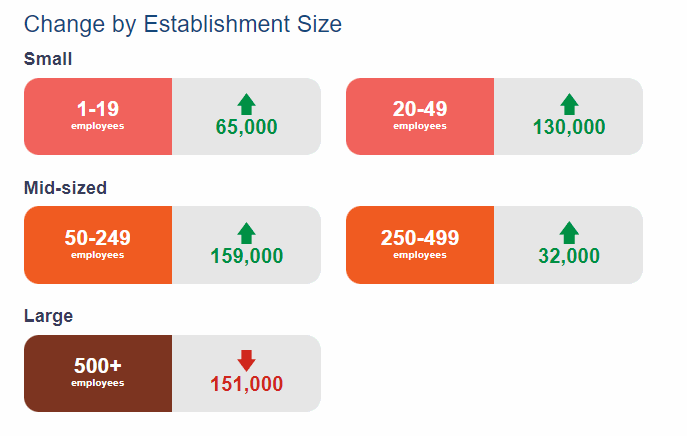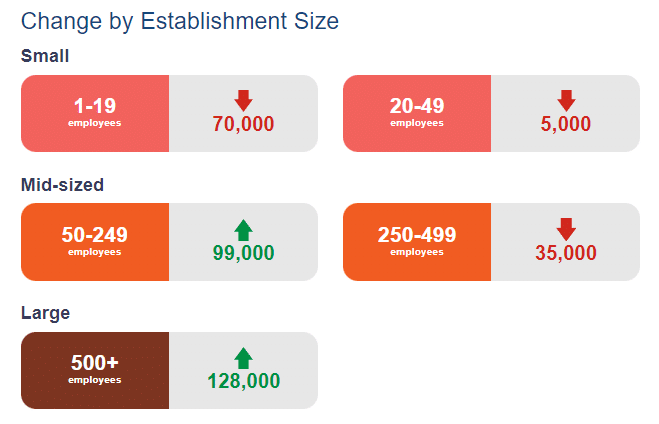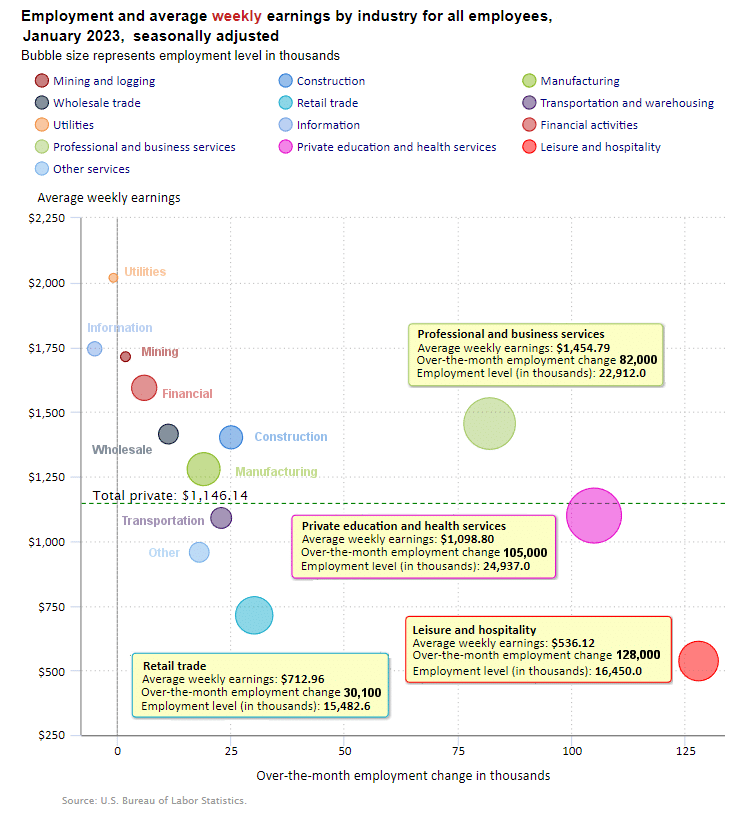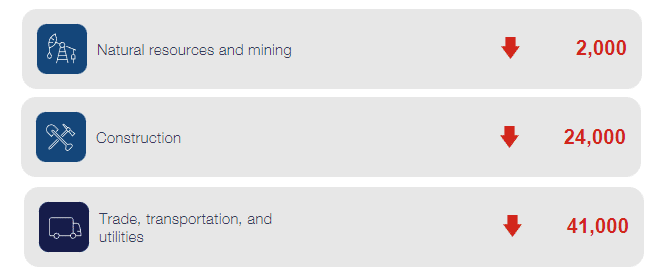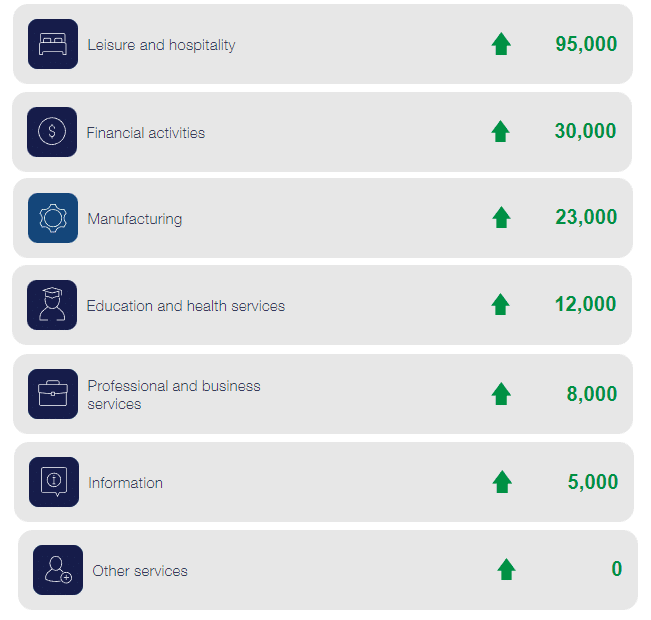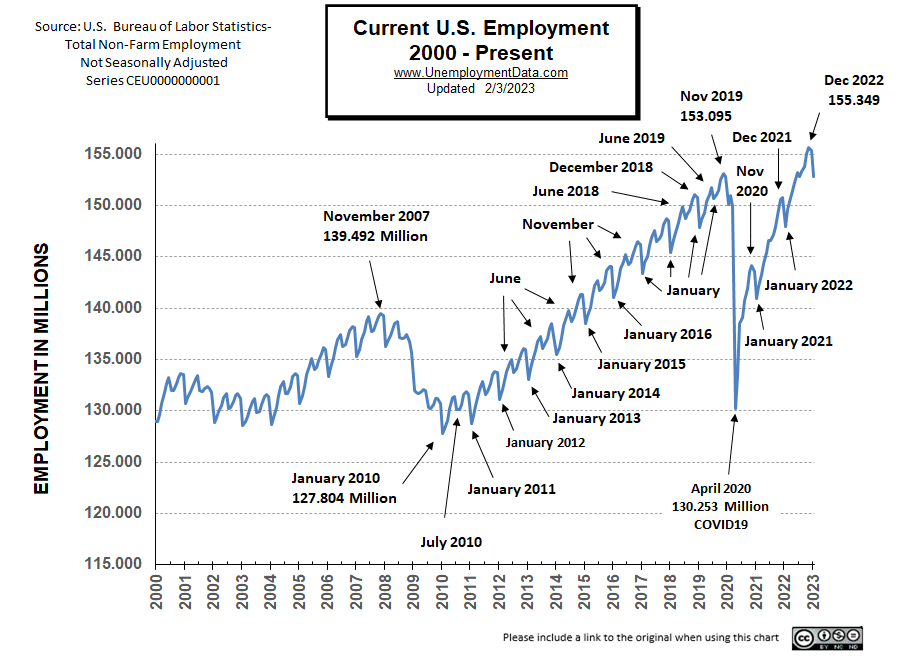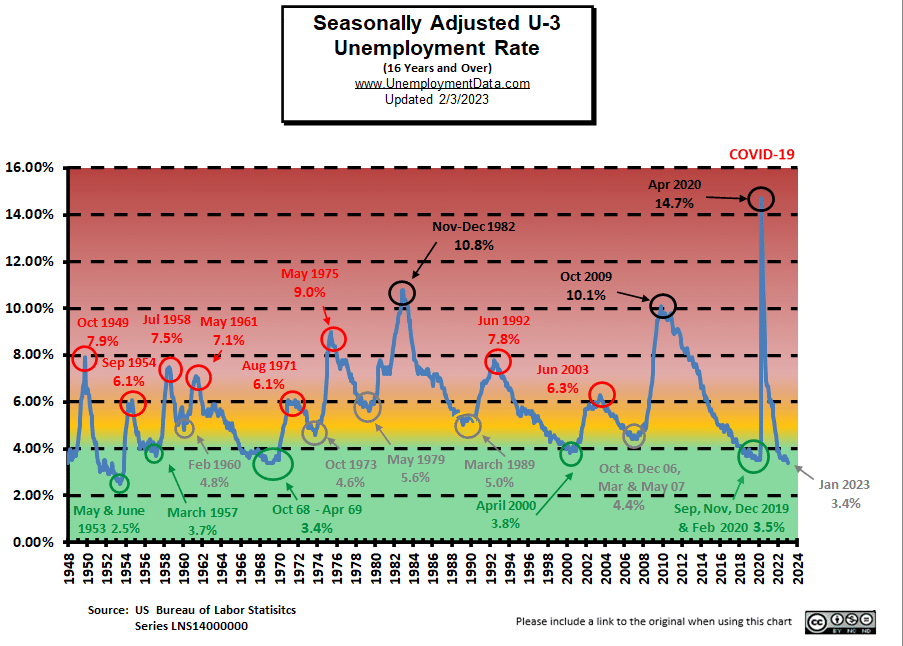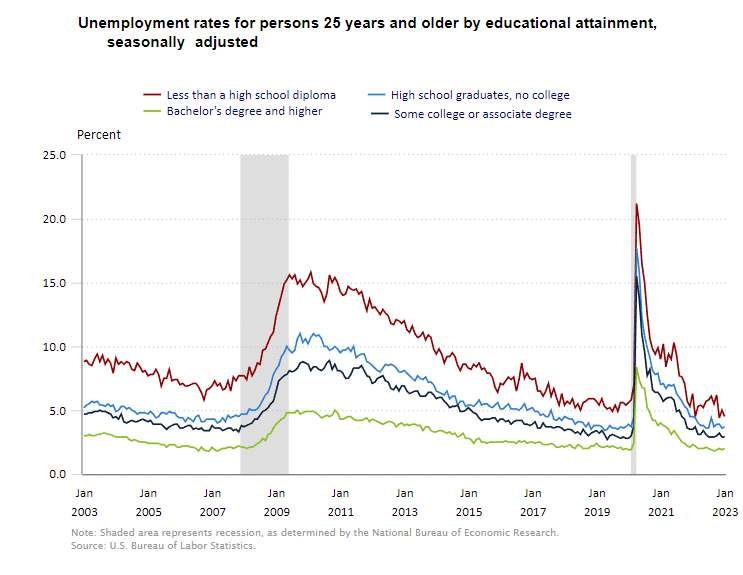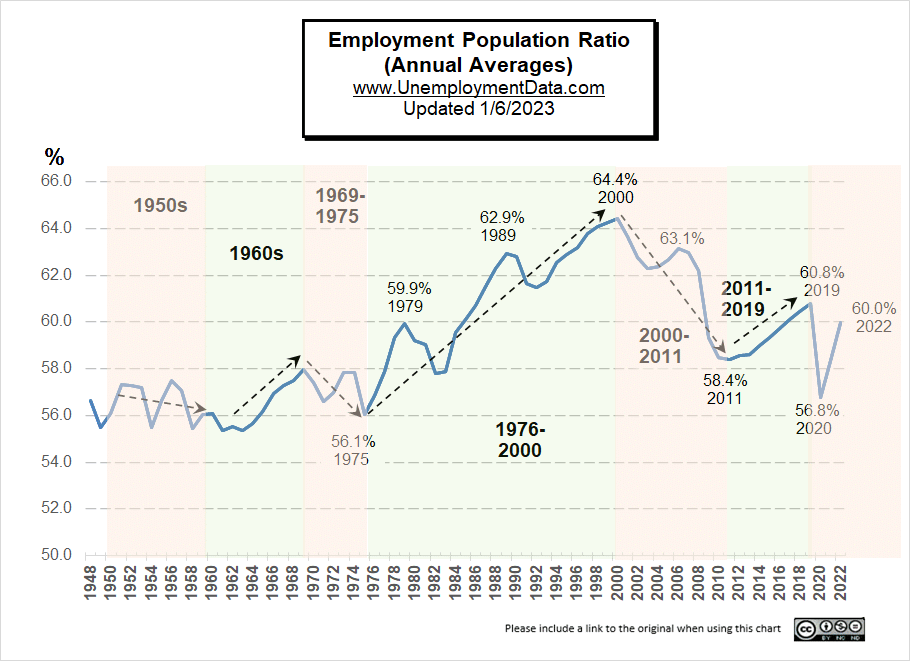The U.S. Bureau of Labor Statistics (BLS) released its employment / unemployment report for January on February 3rd 2023.
Employment Down or Up? – Unemployment Down?
![]()
- Unadjusted Employment fell from 155.349 million to 152.844
- Labor Force Participation rose from 62.3% to 62.4%
- Adjusted U-3 fell from 3.5% to 3.4%
- Unadjusted U-3 ROSE from 3.3% to 3.9%
- Unadjusted U-6 ROSE from 6.4% to 7.4%
According to the Commissioner of the U.S. Bureau of Labor Statistics:
“Total nonfarm payroll employment rose by 517,000 in January, and the unemployment rate changed little at 3.4 percent, the U.S. Bureau of Labor Statistics reported today. Job growth was widespread, led by gains in leisure and hospitality, professional and business services, and health care. Employment also increased in government, partially reflecting the return of workers from a strike.”
In addition, the BLS posted the following note:
“Establishment survey data have been revised as a result of the annual benchmarking process, the NAICS 2022 conversion, and the updating of seasonal adjustment factors.| Also, household survey data for January 2023 reflect updated population estimates.”
You can read the full BLS report here.
As usual, they are talking about “Seasonally Adjusted Jobs”.
Looking at the Unadjusted Establishment Survey report, we see…
Originally the BLS reported employment of 154.771 million for December, which they adjusted up to 155.349 million. So, 578,000 additional jobs appeared for December.
I don’t know if it’s just me but, an additional half million jobs seems a bit exceptional, but perhaps in government work it’s just a rounding error.
The current estimate for January is 152.844 million which is down 1.9 million from the original number and down 2.5 million from the revised numbers. But after Seasonally Adjustment they report a half million increase! Typically, employment does fall off in January so some seasonal adjustment is justified but the half million increase in December seems a bit excessive.
We will see what happens next month.
ADP® National Employment Report
According to ADP In collaboration with Stanford Digital Economy Lab employment was up from December but by about 1/5th as much as the BLS reported. But if employment is up, why is the UNADJUSTED U3 and U6 down drastically? Could it be the extra 1.1 million people the BLS added to the Civilian population? December Civilian Population 264.844 million. January Civilian Population 265.962 million.
ADP: Private employers added 106,000 jobs in January
- Employment was soft during our Jan. 12 reference week as the U.S. was hit with extreme weather. California was coping with record floods and back-to-back storms delivered ice and snow to the central and eastern U.S.

Last month small and medium-sized companies were hiring while large corporations are downsizing. This month it was almost the opposite.
December Changes:
January Changes:
January 2023 Employment by Sector
The employment “bubble chart” is a quick and easy way to see how each sector performs on a seasonally adjusted basis. The Bubble’s Size tells us the total Employment for that industry (i.e., larger bubbles mean more people are employed in that sector).
The bubble’s location on the chart tells us that there has been a change in Employment Levels over the most recent month… A bubble further to the right indicates larger job growth. A bubble’s vertical location on the chart shows the average industry salary.
Average Weekly Wages Rose in January
| Date | Average Weekly Wage |
| January 2023 | $1,146.14 |
| December 2022 | $1,125.73 |
| November 2022 | $1,129.01 |
| October 2022 | $1,124.01 |
| September 2022 | $1,119.87 |
| August 2022 | $1116.42 |
| July 2022 | $1,116.54 |
| June 2022 | $1,106.76 |
| May 2022 | $1,105.47 |
| April 2022 | $1,102.01 |
| December 2021 | $1,086.46 |
Remember, these are Seasonally Adjusted Numbers, so they aren’t cumulative!
BLS Employment and Average Weekly Earnings by Industry
January 2023, Seasonally Adjusted Employment
We’ve added another column to the table below that shows the employment levels that the BLS reported the previous month. Note that due to “seasonal adjusting” although they may claim that there was a “monthly increase” (or decrease), there isn’t always a real increase; you can’t just subtract last month’s “employment level” from this month’s level. For instance, Mining and Logging was supposed to have 644,000 employed in December and have a 2,000 “increase” but in January there were only 631,000 employed. The opposite happened in Construction: December had 7,777,000, and January had 7,884,000 which is a difference of 107,000 but seasonally adjusted it is only a 25,000 increase.
| Industry | January Monthly Increase | Jan. Ave. Weekly Earnings | Employment Level January | Employment Level December |
| Total Private Employment | 443,000 | $1,146.14 | 132,684,000 | 131,302,000 |
| Mining and Logging | 2,000 | $1,713.53 | 631,000 | 644,000 |
| Construction | 25,000 | $1,401.40 | 7,884,000 | 7,777,000 |
| Manufacturing | 19,000 | $1,278.59 | 12,999,000 | 12,934,000 |
| Wholesale trade | 11,300 | $1,414.14 | 6,041,000 | 5,925,400 |
| Retail trade | 30,100 | $712.96 | 15,482,600 | 15,789,500 |
| Transportation and Warehousing | 22,900 | $1,089.50 | 6,740,500 | 6,486,900 |
| Utilities | -700 | $2,018.74 | 555,200 | 544,400 |
| Information | -5,000 | $1,739.92 | 3,065,000 | 3,061,000 |
| Financial Activities | 6,000 | $1,593.00 | 9,114,000 | 8,997,000 |
| Professional and Business Services | 82,000 | $1,454.79 | 22,912,000 | 22,426,000 |
| Private Education and Health Services | 105,000 | $1,098.80 | 24,937,000 | 24,889,000 |
| Leisure and Hospitality | 128,000 | $536.12 | 16,450,000 | 16,051,000 |
| Other Services | 18,000 | $956.73 | 5,819,000 | 5,777,000 |
Source: BLS
Note: As usual, ADP has an entirely different picture with manufacturing, Mining, Construction and Transportation losing jobs instead of gaining them
ADP Job Losers
ADP does break up the categories slightly differently regarding their category Trade, Transportation, and Utilities and these numbers aren’t seasonally adjusted.
ADP Job Gainers
Unemployment
January’s Seasonally Adjusted Unemployment is 3.4%, down from December.
Originally, the BLS reported November’s adjusted U-3 unemployment rate as 3.7%, but they have since revised it to 3.6%, and December’s rate at 3.5% is lower than either of those.
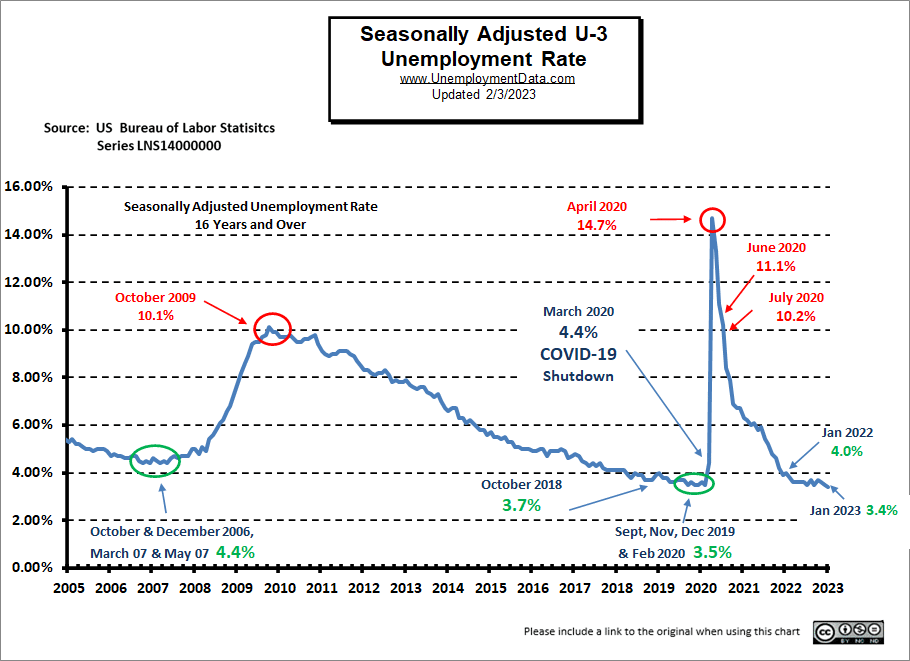
Current Employment Rate Chart
Typically the low point for each year occurs in January. Then employment moves almost straight up to a small peak around June with a slight drop around July, and then the highest peak in employment happens in November with a slight decline in December. In 2021, rather than a decline in December, we saw a slight increase, followed by the typical January decline and a rebound in February through June. Employment peaked at 155.015 million in December, beating the November 2019 peak by roughly 2 million (although the U.S. population has increased by over 4.8 million since then as well).
See Current Employment for more info.
Unemployment Still Historically Low
Unemployment levels are still in the historically low territory. After all, the FED did pump unprecedented TRILLIONS into the economy to get us to this place.
See: FED Actions for more info.
But we can see that Seasonally Adjusted U-3 is definitely in the “Green” territory.
January 2023 Labor Force Participation Rate
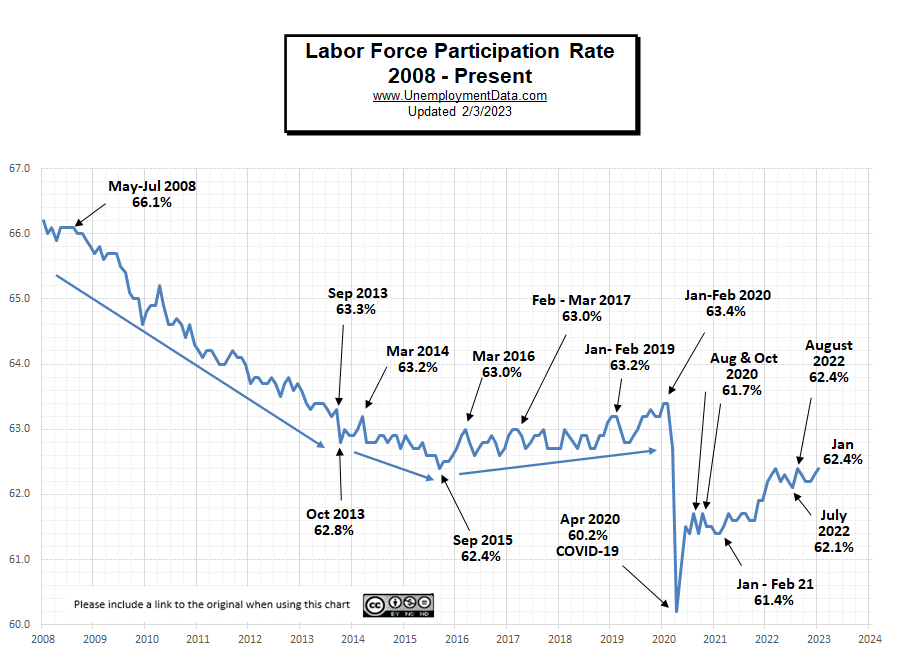
Seasonally Adjusted U1 through U6 Unemployment Rates
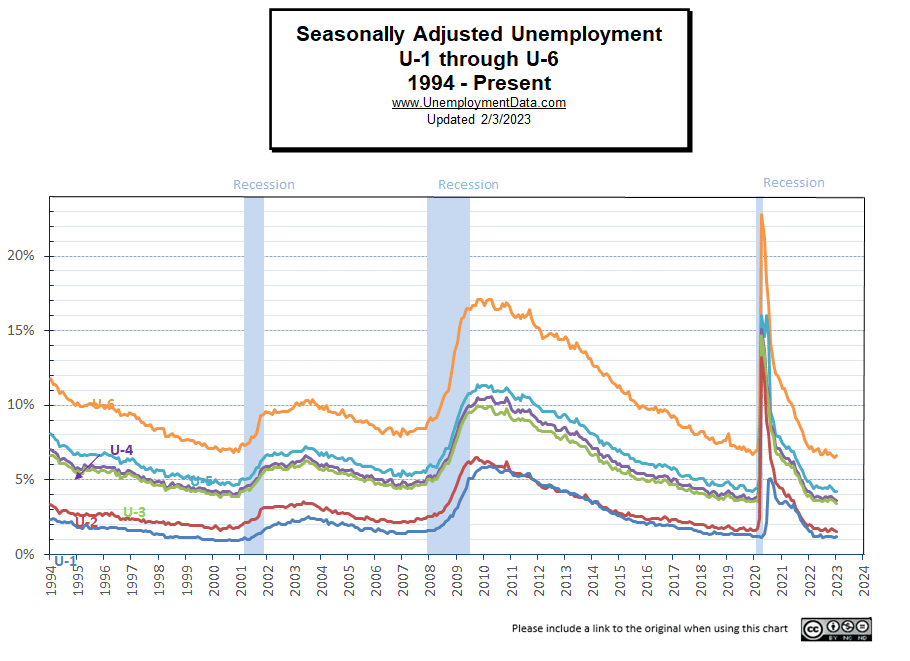
Seasonally Adjusted Unemployment by Education
 Employment-Population Ratio
Employment-Population Ratio
See Employment Population Ratio for more information
Read more on UnemploymentData.com.
- December 2022- Employment and Unemployment by State
- December 2022 Employment Report
- 5 Career Opportunities for Disabled Individuals
- 4 Careers that Don’t Require a 4 Year Degree
From InflationData.com
- Is The Fed Flashing Signs It’s Done Raising Rates?
- Falling Inflation is Good for Stocks
- Why the Fed Is Bankrupt and Why That Means More Inflation
- Inflation Falls Again in December
From Financial Trend Forecaster
- Moore Inflation Predictor
- NYSE ROC
- NASDAQ ROC
- Has the Stock Market Turned Positive?
- Are Countries Getting Smaller?
- Is the U.S. Dollar Hegemony Ending?
- Latest Recession Alarm
- Housing Is Getting Less Affordable
From Elliott Wave University
- 60% stocks, 40% bonds? Ha!
- U.S. Dollar: Has the Mainstream Been Way Too Confident?
- Banks Are Becoming More Cautious About Lending
- Are You Prepared for Widespread Bank Failures?
- Will Another “Great Depression” Start in Europe?
From OptioMoney.com
- 6 Ways to Cope with Bad Financial Decisions
- Simple Ways to Save Money When Shopping Online
- How to Start Saving for Your Education
- 6 Tips for Moving Out of Your Parent’s Home with No Money
- 5 Tips for Paying Off Your Debt
From Your Family Finances

